One of my goals is to encourage people to Rediscover the Joy of being on a bike so wanted to share this short video from People for Bikes for those who haven’t already seen it.
Enjoy – Sky King
One of my goals is to encourage people to Rediscover the Joy of being on a bike so wanted to share this short video from People for Bikes for those who haven’t already seen it.
Enjoy – Sky King
“Saving Your Butt, One ride at a Time” What a great tag line!

Customer feedback and diligent perusal of various on-line forums (somebody’s got to do it, the internet’s not going to read itself!) encouraged us to stock the Selle Anatomica saddles in the store. The saddles have a long cutout intended not only to relieve pressure but to allow the two sides of the saddle to move independently.
We have not had the chance to test these saddles but Selle An-Atomica claims there is no break in period. Here we compare and contrast the Selle An-Atomica Titanico and the Brooks B-17 Imperial:
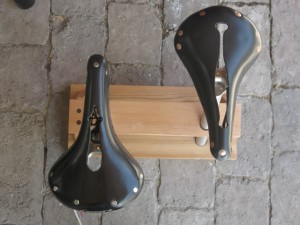




How much does it cost to go bike touring? Well, I guess it depends on the person(s). Some people can travel for next to nothing by eating store bought food rather than at restaurants and by stealth or wild camping wherever they happen to end up at the end of the day. Websites like CouchSurfing and Warm Showers connect travelers with people who are willing to provide a couch or a yard or even a bed.
Russ over at the Path Less Pedaled recently did this interview with Heidi Beierle who rode her bike across the country and wrote her master’s thesis on looking at bicycle tourism as an economic development tool for rural communities. While not specifically about how much it costs to do a bike tour she does delve into that aspect.
httpv://youtu.be/X-XwCoOKHoQ
My recent 6 day and 5 night ride from Portland to Idaho broke down this way:
Food – $116.00
Mostly from grocery stores, with the occasional restaurant stop thrown in. Works out to about $19.30 per day.
Camping – $34.00
The most expensive night was $24.00 for a KOA. Two nights of wild camping for nothing and two nights in state parks at $5.00 per night. Average = $8.50 per night.
I also bought some fuel for the stove and some batteries and a memory card for the camera, but if I amortize those expenses over the life of those items it works out to pennies a day. For this trip I FedEx’d the bike to Portland and that cost $67.83. Shipping the empty box back home cost $30.35. The cheap airline ticket to Portland, bought far in advance, was about $60.00.
So the total cost for the six day vacation with all the expenses thrown in was about $300.00. If I just look at the time when I was on the bike, and don’t count the flight and shipping expenses, the six days cost me about $150.00 or $27.80 per day. Pretty cheap therapy methinks.
View Larger Map
Sometimes it feels as though everyday is a brand new kick in the teeth. I’m no different from anybody else. We all have our own personal Mt. Everest to climb and sometimes it feels like we are on the Hillary Step….our oxygen bottle has quit working and our crampons are loose.
From time to time, I need to escape. The best way I know of to do that is to load onto my bike everything I need in order to live for a few days and start pedaling. It might appear as if I’m being selfish to do that. It might appear to be a little bit odd and not that much fun. But I know that for those few days, I am a different person with different problems and a different set of needs, and the person I was, with his problems and worries, is far, far away.
I made plans to ship my bike to Portland two weeks ago and then ride it back to Idaho after the Oregon Manifest Constructor’s Challenge, which we were attending as members of the press. Here are some random reports and thoughts from my ride across Oregon:
Riding in Portland
I am continually amazed by the number of people who really use their bicycles in Portland and by the infrastructure for bikes that is in place. Dedication to bicycle travel is much more than lip service here.
The Boogey Man Forest
When night falls in these Doug Fir and Ponderosa Pine old growth forests, it falls like a drunken man who blacks out when his head smacks the pavement. It is not possible to see ones hand in front of ones face. Alone in the National Forest campground and completely covered up by darkness, I slept like a dead man for 11 hours.
KOA Kamping, and Kross Kountry Riding
I could have got by cheaper than the $24.00 I was charged for a tent site at the KOA by finding an RV park with tent sites. But I knew KOA’s have nice clean facilities with showers and laundry, and I was wet and tired. Next day I used the Droid to find an alternate route to the state highway rather than backtracking 7 miles back to Madras. A little scenic detour on dirt roads and I was golden.
Wild Camping
In the Ochoco National Forest I had the opportunity to spend $13.00 for a tent site without so much as water. I opted to ride another mile and pitch camp a hundred yards off the highway in the forest. I actually felt pretty comfortable for my first wild camping experiment, but I was extra careful with the stove because fire hazard was off the charts in Oregon this year.
Lucas
Lucas has been on the road for about ten weeks, having started in Central Park in New York City. He was still fired up though and he said he didn’t really have any expectations but was always excited to see what was around the next corner. An attitude I was to remember and take to heart for the rest of my trip.
Oregon State Parks
Clean, well maintained and cheap. Five dollars for a tent site in the hiker/biker areas in the Oregon State Parks includes all the facilities, such as showers. Oregon is serious about encouraging bicycle travel.
Water Lady
Just outside of Prairie City begins the 1700 foot climb to Dixie Pass which tops out at 5276 feet. Near the top a car pulled off and the woman who was driving asked if I needed anything. I let her fill my water bottles as she told me she had ridden this pass in 1996 on her way across the US on bike. Now she always tries to stop when she sees tourists to see if there is anything they need. Very thoughtful and I appreciated it.
Serendipity
After Dixie Pass I knew I still had two more summits that day before stopping for the night. In my mind the 5100 foot pass came first and then a 4500 footer. At the top of the big pass I again checked my maps and realized that the shorter climb had come first and it was all downhill to Unity Lake State Park. Nice surprise!
Then when I finally pulled into the park, the ranger happened to be there and told me that even though it was not shown on their board, they did indeed have hiker/biker sites and he pointed them out to me. I decided to appreciate the little things that did work out today instead of focusing on the fact that park was full to overflowing with hunters and their noisy, smelly rigs and their impossibly bright lanterns and spotlights.
Notes to self:
Get some better sunscreen for my lips. I still have blisters 3 days later.
Get a handlebar clamp for the Droid
Bring the video camera
Bring a small pad to use to sit on
I judged the entries by how they incorporated the mandatory design features outlined on the Oregon Manifest site:
-Anti-Theft System
-Fender System
-Lighting System
-Load System
-Free-Standing Under Load (While Parked) System
With a heavy bias toward integration, quality of execution and aesthetics.
In no particular order, I thought these bikes were outstanding.
YiPsan Bicycles
This bike has a two legged kick stand and, depending on how the load is distributed, is balanced in such a way that either the front or rear wheels are off the ground, facilitating flat tire repairs.
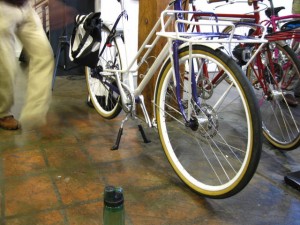



There is a Dutch bike style lock which is attached to the frame and locks the rear wheel so that it can’t be turned, and Renold inserted a braided steel cable into the seat post of the bike which can be pulled out and locked into the wheel lock mechanism.

With fenders, internally geared rear hub, belt drive, generator lights and great load carrying capacity, this bike’s got it covered. And it fits Leah like a glove.
Bauhinia – YiPsan Bicycles from YiPsan on Vimeo.
The more I looked at this bike, by Geekhouse, the more I liked it. I talked to the builder at the lunch stop and took these pics.

I thought this was a really creative frame design. Not a traditional double diamond frame, rather an inverted curve or an arch, the other strongest shape, basically forming the seat stays and rack. The double top tubes curve down and sweep back to form the rear rack, also establishing a low stand over height.
The rear skirt guard and front fender design could be improved to provide better spray coverage. And again the ubiquitous Shimano Alfine internal gear rear hub and front dynamo hub. The front light was actually integrated into the stem.

The shaft of the u-bolt lock is built into a short piece of tubing welded to the two pivot points on the top tube. The shackle portion of the lock is strapped down when riding and pivoted up and removed to lock the bike to a post or bike rack.

Another bike I was drawn to is the Fremont a collaboration between Ziba and Signal Cycles.

This is one of several side-car designs at the event, but it seemed like the most practical of the bunch to me because the side car folds up over the rear fender to become a rack. And the side car met the additional requirement of providing a support for the parked, loaded bike. The canvas bags were made for the team by a local Portland seamstress.



I thought these bikes met the challenge requirements in elegant ways and I can see how they would be practical and functional in the real world.
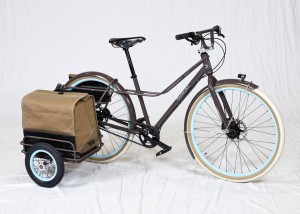
As the Bike Hermit makes his way back to the bike cave from Portland on Chief, Sky King thought it would be a good idea to provide a link to the updates on the Oregon Manifest Website. Some high quality photos and interviews with the builders and the judges.
Dan Boxer makes Boxer Bicycles. For the 2011 Oregon Manifest Constructor’s Challenge he came up with this “cycle truck” He told me it’s a departure from his normal bike, but he has a pretty new addition to the family (congrat’s Dan) and he wanted a utility bike that he could ride to the store and bring his son along.



One feature that does seem to recur with Boxers (I remember the same thing on his 2009 entry) is the chain catcher on the rear dropout. Instead of a cog, the 9th position on the 9 speed cassette body is a steel ring which is part of the frame. the last position of the 9 speed shift lever will drop the chain onto this ring where it stays while the rear wheel is removed in the event of a flat tire. I expressed my concern that I personally would continuously inadvertently shift onto the steel ring, but Dan said it’s a pretty short learning curve and it doesn’t happen that often.

Folk Engineered / Discovery Charter School
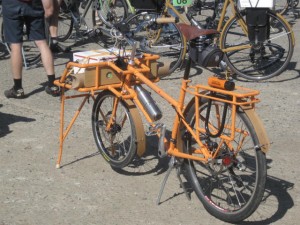

“An industrial designer collaborating with a shipbuilder” is the description Art+Industry gives their working relationship. My initial reaction to a plywood bike is to wonder how durable it would be. But then boats and high performance aircraft have been made from wood for a long time.
Watching this bike being ridden up hill and out of the saddle I could see no flexing of the body. The designer, Michael Downs, was riding the bike and he was lamenting not having an easier gear. Another entrant who maybe was a little surprised by the difficulty of this ride for a full on, robust utility bike.
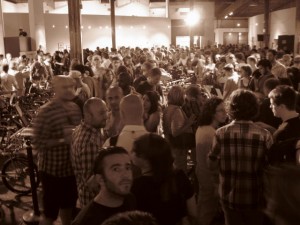

With over 30 entries the 2011 Oregon Manifest Constructor’s Challenge is a challenge for the reporter. I have decided to break the reviews up into categories, the first installment of which will be cargo bikes. These are bikes loosely in the tradition of the Dutch Bakfiets or freight bikes with a large platform or container in front of the front wheel or in between the two wheels.


This bike was a collaboration between Metrofiets, Tonic Fabrication, Suppenkuche, Vulture Cycles, and Bespoke Cycles. You can listen to our interviewwith Phillip Ross from Metrofiets in Portland, OR.
The Oregon Manifest Creative Collaborations partner three of the world’s top design firms with accomplished custom bike builders, to push the boundaries of what a modern utility bike can be.
This bike
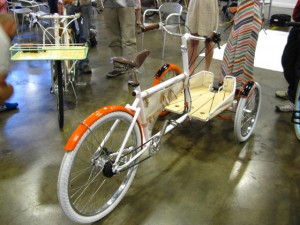
was a collaboration between Fuse Project and Sycip Cycles. For the first ten miles of the ride part of the challenge this bike carried human cargo. It didn’t look too comfortable, but showed that the bike was capable.
Francis Cycles is Joshua Muir from Santa Cruz, CA.



We were privileged to go along on the press tour of the Chris King factory in conjunction with the 2011 Oregon Manifest Constructor’s Challenge. I had no expectations for the tour but I came away with a better understanding of what an important company this is. It is the company that doesn’t exist in America anymore. Here is a maker of precision bicycle components that employs over 90 people. And they make everything used in their finished products. They even make their own ball bearings.
Originally known for the headset which has become the standard for durability and function (Chris has the first headset he made in 1976 sitting on his desk) the company also makes hubs, bottom brackets, cogs and lockrings, and tools for servicing their products.
The real story behind all these shiny parts is maybe as fascinating as the parts themselves. The first thing one notices on entering the factory is the smell of machine oil. And this is where the story of commitment to employees and sustainability becomes apparent. First of all the oil used here is soy based, not petroleum. The machines on the floor of a factory such as this throw off clouds of oil and here they have implemented a recovery system that recycles this oil that could be wasted and lessens the health risks to workers.
The machines also throw off a lot of shavings, aluminum or steel. And to recycle the shavings they need to be cleaned of the residual oil, which is also recycled, resulting in a barrel of oil being recovered every month or so.

We were treated to lunch in the employee’s cafe. A bean counter might not encourage building an employee cafe. But in terms of employee satisfaction and productivity, it makes sense.
The employee bike storage area was well over half full of bikes even though this was Friday and most people work four tens, Monday through Thursday. Employees gain cafe credits for riding their bike to work and they receive days off based on how much they ride to work. There is a complete locker room with showers provided for employees.
To my mind this is the best kind of bicycle advocacy, if the intent is to get more people on bikes. Many employees come to Chris King as non-cyclists. They may get an inexpensive cruiser one year in order to take advantage of the perks. The next year they might upgrade to a hybrid and the pattern is established.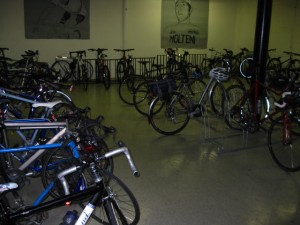
Oh yeah, they make bike frames too. Chris made his first frame in 1978. Now, in a corner of the factory building, is made the Cielo line of bicycles. All of the parts for the frames including the fork crowns and dropouts are made in house too.


As much as the manufacturing process contributes to environmental responsibility, so does the fact that the components made here are made to last. Many Chris King headsets are in the third, fourth of even fifth bike of their service life. And that, my friends, is a good value.
The Bike Hermit joins the group today as the Oregon Manifest Field Trials get underway. The entrants are only allowed to take a tube and tire levers as the ride is the true test of the bikes integrity. We hear that surprises are in store along the way. Am counting on the Bike Hermit to give us a full report.
Last nights meet and greet was packed and the bikes were well received. Today’s ride wraps up with a big celebration at Chris

King. We were able to score a great tour of Chris King on Friday, feeling pretty special to be considered part of the “Press”
